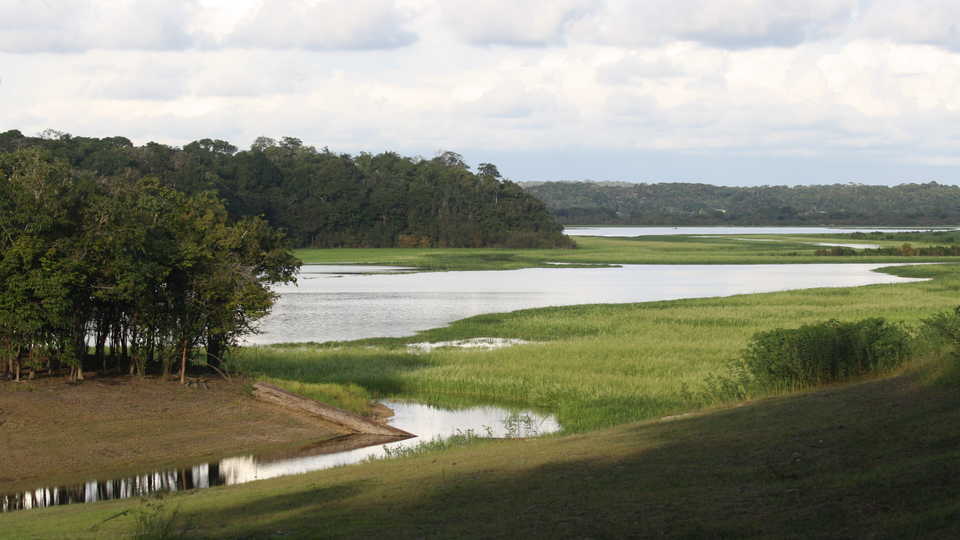Students will be able to:
- describe the various processes of the water cycle.
- understand that water changes forms throughout the water cycle and that this cycle runs continuously with different processes happening at the same time.

© Stephen Horvath
The Amazon River in South America is considered the largest river on Earth. With all this water, rainforest plants rarely lack this essential resource; instead, plants regularly release the excess water. This helps keep the forest cool, and water vapor can collect into clouds and eventually fall as rain. The water cycle of the rainforest is an important key to keeping the forests healthy and strong. In this fun role-playing skit your students will be able to describe the various processes of the water cycle in the Amazon. By performing the skit they will understand the changes water goes through throughout the water cycle and that this cycle runs continuously with different processes happening at the same time.
Students will be able to:
Teacher Tip: Be prepared for a degree of noise and chaos (and fun!) as the cotton balls start traveling and your whole class calls out their lines at the same time. Set some clear expectations for student behavior ahead of time to keep things manageable, and establish a signal that will tell students when to stop the role-play.
Discuss the following questions:
The Amazon River basin of South America is considered the largest rainforest on Earth, traversing the countries of Brazil, Bolivia, Peru, Ecuador, Colombia, Venezuela, Guyana, Suriname, and French Guiana. The Amazon River flows east, beginning in the high elevations of the Andes Mountains and traveling 6,400 km (4,000 miles) to the Atlantic Ocean off the coast of Brazil. Although second to the Nile River in length, the Amazon is the largest of the world’s rivers by volume, holding 20% of Earth’s available fresh water. This volume is created by an impressive system of over 15,000 tributaries (smaller rivers and streams) feeding its flow. At its mouth, the Amazon River pours an average of 200,000 cubic meters (50,000 gallons) of river water into the Atlantic Ocean each second!
With water prevalent, rainforest plants rarely lack this essential resource; instead, plants regularly expel excess water. By transpiring water from the underside of their broad leaves during the warm daytime, trees draw water up the stem so that soil nutrients dissolved in the water may spread throughout their tissues. This transpiration, in turn, contributes to constant rainfall by providing water vapor to the atmosphere. The vapor will eventually form clouds that provide rain for the rainforest habitat. The Amazon Rainforest is particularly efficient with recycling water in this way, recycling at least 50% of the local water in the form of precipitation. Estimates for the volume of water moved via the combined processes of evaporation and transpiration average 9 x 1012 m3/yr, which means the Amazon Basin contributes 6.5 trillion gallons (6,500,000,000,000 gallons) of water to the atmosphere each day!
The items listed below indicate how the activities supports the three dimensions of the Next Generation Science Standards:
Science & Engineering Practices:
Disciplinary Core Ideas:
Crosscutting Concepts:
Related Performance Expectations
Remember, performance expectations are not a set of instructional or assessment tasks. They are statements of what students should be able to do after instruction. This activity or unit is just one of many that could help prepare your students to perform the following hypothetical tasks that demonstrate their understanding:
MS-ESS2-4: Develop a model to describe the cycling of water through the Earth’s systems driven by energy from the sun and the force of gravity. [Clarification Statement: Emphasis is on the ways in which water changes its state as it moves through the multiple pathways of the hydrological cycle. Examples of models can be conceptual or physical.] [Assessment Boundary: A quantitative understanding of the latent heats of vaporization and fusion is not assessed.]
Barreto, P., E. Arima & M. Brito (2005). Cattle Ranching and Challenges for Environmental Conservation. “State of the Amazon” series, nº 5. Belém: Imazon.
Cherry, L. (1990). The Great Kapok Tree: A Tale of the Amazon Rain Forest. Harcourt Brace: San Diego.
Gash J.H.C., C.A. Roberts, J.M. and Victoria, R.L. (Eds.). (1996). Amazonia deforestation and climate. J. Wiley and Sons: UK.
National Geographic Society (2003). Amazon River and Flooded Forests Ecoregion. Retrieved from: http://www.nationalgeographic.com/wildworld/amazonriver/
National Zoological Park, Smithsonian Institution (2007). Amazon Basin Facts. Retrieved from: http://nationalzoo.si.edu/Animals/Amazonia/Facts/basinfacts.cfm
World Wildlife Fund (2001). Amazon River and Flooded Forests. Retrieved from: http://www.nationalgeographic.com/wildworld/profiles/g200/g147.html